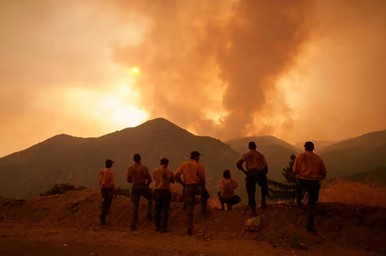
U.S. Emergency Crews Struggle as Climate Crisis Fuels ‘Unprecedented' Competing Disasters
Resources Strained as Southeast Faces Hurricanes and West Endures Heat Waves
This past week has been particularly brutal in the U.S. due to a series of weather-related disasters. While large parts of the Southeast grapple with the aftermath of Hurricane Helene, another potentially catastrophic storm, Hurricane Milton, is approaching Florida. At the same time, the western U.S. is sweltering under extreme heat, increasing the risk of wildfires.
While hurricanes and wildfires are not unusual during early autumn, the climate crisis has exacerbated these events, allowing for overlapping catastrophes that strain emergency response resources and complicate relief efforts.
Federal officials have stated that emergency response agencies are managing recovery efforts following Hurricane Helene, countering misinformation about the misallocation of funds in affected areas. However, the simultaneous disasters are placing severe pressure on these agencies.
Homeland Security Secretary Alejandro Mayorkas expressed concerns, stating that FEMA "does not have the funds to make it through the season." President Joe Biden echoed this sentiment in a letter to Congress, urging lawmakers to increase funding to ensure that FEMA can maintain support for both short- and long-term recovery efforts. "The Congress should provide FEMA additional resources to avoid forcing that kind of unnecessary trade-off," he wrote.
In the West, dangerous fire conditions led to the U.S. adopting a preparedness level 5 (PL5) on Tuesday, the highest possible level. This early-October designation is notable as it marks the latest PL5 since the National Multi-Agency Coordinating Group (NMAC) began tracking these levels in 1990. The declaration indicates a scarcity of resources for firefighting, particularly as conditions extend into autumn.
Firefighters have logged up to 1,400 hours of overtime this season, with blazes covering over 7.6 million acres in the U.S. so far this year. With budgets tightening and seasonal crews dwindling, agencies are stretched thin as they also deploy over a thousand wildfire personnel to assist in recovery from Hurricane Helene.
In response to the unprecedented fire environment, NMAC has called for a pause on prescribed burns, limiting the scope of mitigation work for the autumn. They warned that the current weather and fuel conditions pose a risk for new ignitions, which could further strain national firefighting resources.
Interconnected Climate Risks
As the U.S. navigates these crises, experts warn that the risks of hurricanes and wildfires are increasingly intertwined. Dr. Dave Easterling, a senior climate scientist at the National Centers for Environmental Information, noted, "Out west you have heatwaves, fire, drought – they all go hand in hand."
Hurricane Milton rapidly intensified to a category 5 storm, threatening Florida just weeks after Hurricane Helene caused widespread destruction and claimed over 230 lives. As these storms become more powerful, they pose increasing challenges for emergency responders and communities alike.
The ongoing heatwave also prolongs fire seasons, raising the risk of hurricanes, particularly as warm Gulf waters fuel storm intensity. This year is on track to be one of the hottest on record, with 2023 logging 28 billion-dollar disasters—an unprecedented number, according to NOAA officials.
Even with increased funding, agencies struggle to keep pace with rising disaster costs. Jonathan Sury, a senior staff associate at Columbia University, pointed out that while FEMA's budget has expanded, the scale of disasters has consumed those funds rapidly.
Future planning at the community level is essential for adapting to worsening climate threats. Sury emphasized that while some aspects of climate change are inevitable, communities can better manage resources during disasters.
In the meantime, scientists urge the public to take warnings seriously. Easterling shared a personal account of the devastating rainfall from Hurricane Helene in his North Carolina community, where neighbors experienced record-breaking flooding.
"The bottom line is when you hear warnings, take them seriously," he said. "We are not going to necessarily see more hurricanes in the future, but when the sea surface temperatures are as warm as they are, especially in the Gulf, we will see more powerful ones."